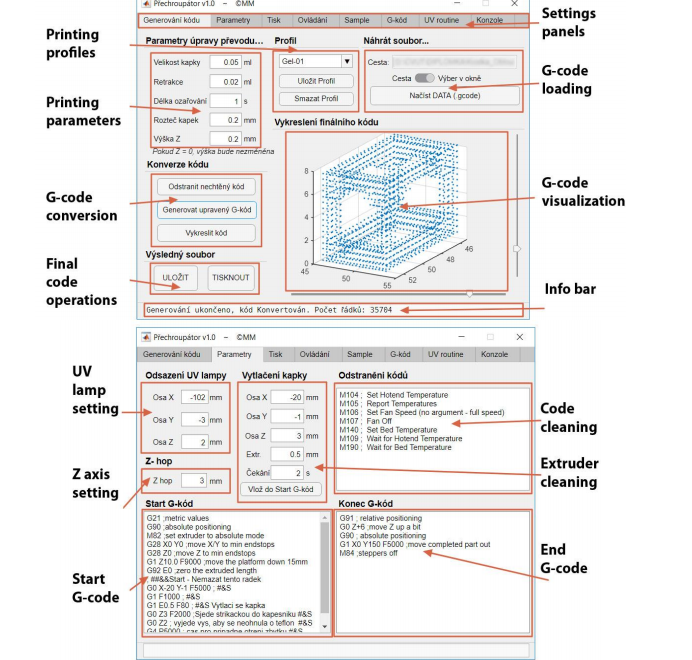Zavřel, M. Michalák, and T. Vampola, researchers from Czech Technical University in Prague, delve further into 3D printing with hydrogels—outlining their findings in the recently published ‘3D printer modification for printing of HEMA hydrogel.’ It’s notable that the University which sits in the home city of Prusa Research did not use a Prusa machine but rather a Velleman.
Working with a popular medium today—especially for a wide range of bioprinting as hydrogels are fabricated with complex gradients, used in direct ink writing, experiments with conductivity, and more—the authors are impressed with the versatility of hydrogels, and motivated to modify 3D printing techniques to better match the performance potential of the materials.
The open-source community in regard to 3D printing offers enormous latitude to users, and especially researchers who are now able to make changes as needed—and affordably so, when previously budget issues may have prohibited certain studies or desired modifications during experimentation.
Made up of HEMA (2-hydroxyethyl methacrylate), a crosslinker (about 0,5 % of ethylen dimetacrylate – EDMA) and an initiator (activator), hydrogels may also be enhanced with water for required swelling.
“Depending on the composition of the hydrogel, the polymer is then able to absorb from 10 % to 600 % water relative to the dry weight,” explain the authors. “These properties are crucial to successful 3D printing.”
Hydrogels are used in 3D printing most frequently via extrusion, with water added for more complex geometries to add stability for support structures. Hydrogels may also be connected to inkjet printheads as an alternative technique, mainly for fabrication of smaller objects with defined features.
For this study, the researchers worked with—and customized—a Velleman K8200. In extrusion, the research team relied on a thin-needle syringe, filled with hydrogel. Droplets were extruded, and the fabricated form was then cured by UV light.
To accentuate the hardware for better printing with hydrogels, the team modified the extruder, along with refining the firmware. G-code was modified, and conversion software was created, allowing for a new translation of lines, arcs, and more. Overall, the amount of work the researchers had to do was considerable, and as they referred to it, ‘lengthy.’ The MATLAB control software allowed for better previewing and online changes to the G-code.
“A simple object was chosen to test the functionality of the hydrogel printer. Fig. 4 [below] shows the droplet formation at the end of the needle as well as the printed line. This type of printer is suitable for printing larger objects that do not require high printing accuracy. The resolution is dependent on the size of the droplet and thus the inner diameter of the needle. However, this dimension is closely related to the need to accurately meter the amount of extruded hydrogel that limits the use for detail printing,” concluded the researchers at the end of their study.

Printing the droplet at the end of the needle (left) and demonstrating the printing of the line from the droplets (right)
What do you think of this news? Let us know your thoughts! Join the discussion of this and other 3D printing topics at 3DPrintBoard.com.
[Source / Images: ‘3D printer modification for printing of HEMA hydrogel’]Subscribe to Our Email Newsletter
Stay up-to-date on all the latest news from the 3D printing industry and receive information and offers from third party vendors.
You May Also Like
3D Printing Unpeeled: New Arkema Material for HP, Saddle and Macro MEMS
A new Arkema material for MJF is said to reduce costs per part by up to 25% and have an 85% reusability ratio. HP 3D HR PA 12 S has been...
3D Printing News Briefs, January 20, 2024: FDM, LPBF, Underwater 3D Printer, Racing, & More
We’re starting off with a process certification in today’s 3D Printing News Briefs, and then moving on to research about solute trapping, laser powder bed fusion, and then moving on...
3D Printing Webinar and Event Roundup: December 3, 2023
We’ve got plenty of events and webinars coming up for you this week! Quickparts is having a Manufacturing Roadshow, America Makes is holding a Member Town Hall, Stratafest makes two...
Formnext 2023 Day Three: Slam Dunk
I’m high—high on trade show. I’ve met numerous new faces and reconnected with old friends, creating an absolutely wonderful atmosphere. The excitement is palpable over several emerging developments. The high...


































